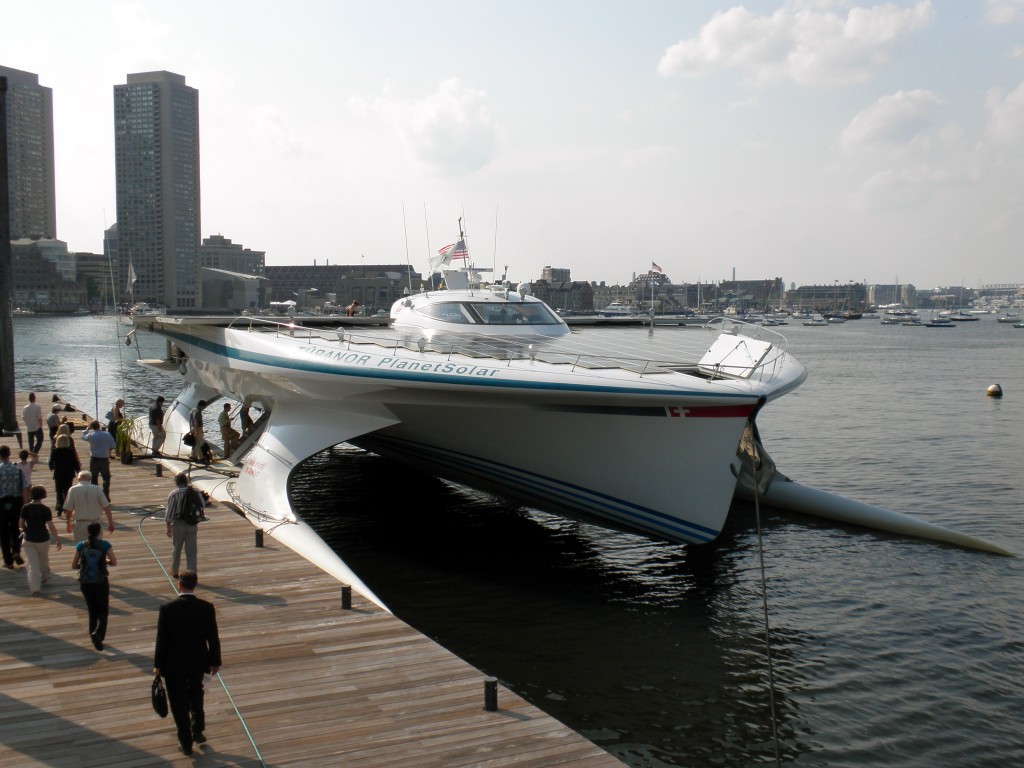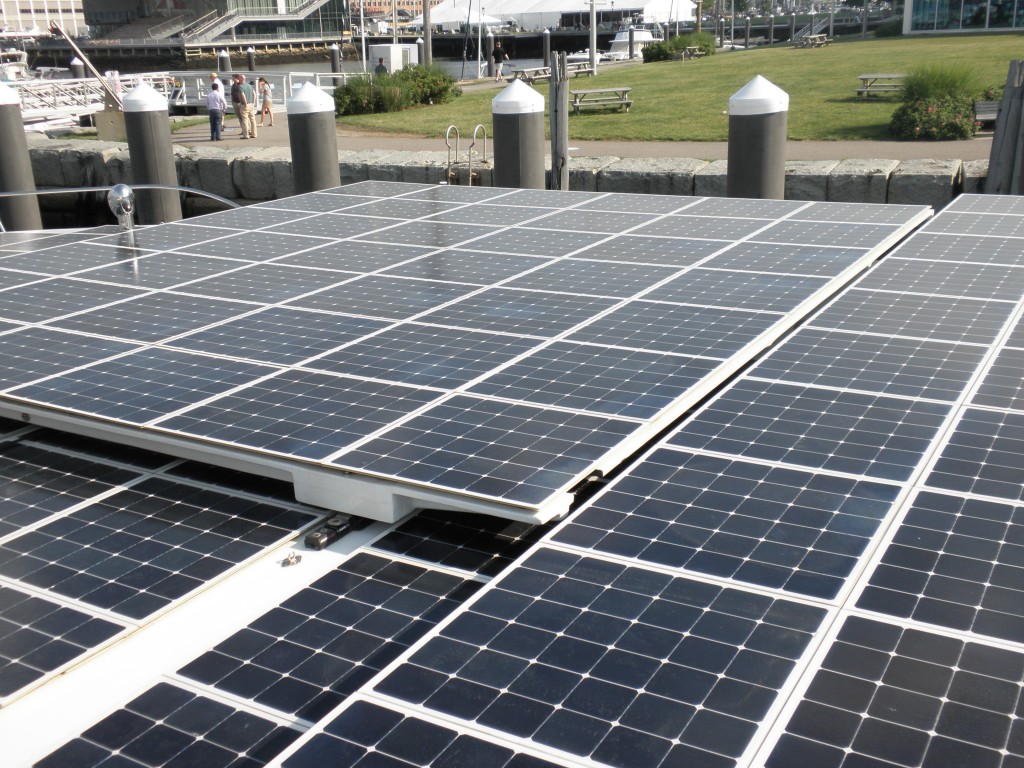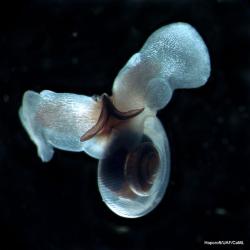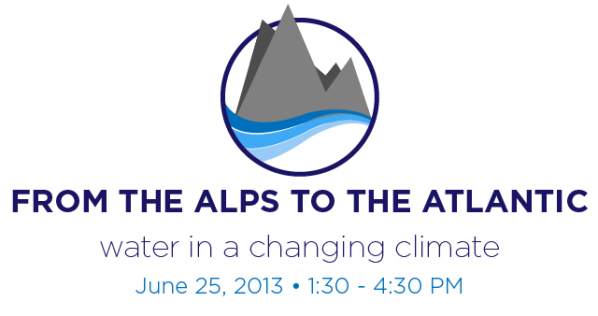Featured Stories | June 28, 2013
Highlights from Boston’s SwissNex Conference…and a Float on a Solar Boat
By Genevieve Wanucha
On Tuesday, Switzerland made a splash in Boston. SwissNex, a part of the Swiss consulate that builds bridges between scientific innovators between Switzerland and North America, hosted “From the Alps to the Atlantic: Water in a Changing Climate.” This series of talks by researchers from Woods Hole Oceanographic Institution and the University of Geneva, pulled together in just three months, focused on how rivers, lakes, and oceans will respond to climate change. We’ll get to a couple highlights of the day’s climate talks in a moment. But best things first: the solar boat.

The researchers visiting from the University of Geneva were all members of the 2013 PlanetSolar DeepWater expedition team. So after the talks wrapped up, they led the audience down Boston’s waterfront to Fan Pier and aboard their 100-ft research vessel–which at first sight looks like it came from the pages of an Arthur C. Clark novel. It is the MS Tûranor PlanetSolar, the first solar-powered boat to circumnavigate the globe, decked out with 5,500 square feet of photovoltaic cells whose generated power flows into eight tons of lithium-ion batteries.
You can tell as soon as you step into the boat’s spacious interior clad with modern looking couches that this catamaran wasn’t originally meant to be a scientific research vessel. Indeed, the project emerged out of Swiss eco-adventurer Raphaël Domjan’s crazy bet in 2004 that he could take trip around the world using solar energy alone. German businessman Immo Ströher funded the boat’s creation, and in 2012, the largest solar boat in the world made the epic 584-day 60,000-km voyage. But something special makes the boat uniquely suited to studying the ocean’s role in climate.

Because the MS Tûranor PlanetSolar runs exclusively on the sun, it does not produce greenhouse gases or aerosols. So, scientists on board are able to take uncontaminated air samples near the sea surface. “The PlanetSolar expeditions may help researchers find out whether plankton contributes to the production of sulfate aerosols,” says Yavor Kostov, a graduate student in the Department of Earth, Atmospheric, and Planetary Sciences, who attended the event. “This unresolved question is one of the mysteries of the climate system.” Aerosols, or small airborne particles, partially counteract the warming influence of greenhouse gases because they scatter and absorb sunlight and promote cloud formation, reducing the amount of energy reaching the Earth’s surface. Emerging evidence points to a role of aerosols in suppressing storms over the Atlantic, so information about a potentially large, natural source of aerosols will be critical to climate and weather predictions. And, studying climate change on a boat releasing no emissions just seems right.
The 2013 PlanetSolar expedition, led by Martin Beniston, professor at University of Geneva, will also collect data on phytoplankton and oceanic eddies in the Gulf Stream, enabling the team to find whether the water conditions in eddies lead to greater or less biological diversity than other places.
Members of the research team hung out above deck to talk about the experience of researching on a solar boat. A common question they received was how the ship deals with bad weather or when the batteries empty. It turns out that the boat can sustain a voyage for 3 days when fully charged. But challenges arise with heavy winds and waves, which can quickly drain battery power. “We have to plan trips according to the weather predictions, making sure we have a good stretch of sunny days,” said PlanetSolar scientist Elena Gascon Diez, a PhD student studying heavy metals in lakes at University of Geneva. “Otherwise, we would just float.” The ship captain, Gérard d’Aboville, monitors a laptop for constantly updated maps from France’s national meteorological agency. It’s useful to avoid falling beneath the shadow of cloud.

So, rewinding a couple hours, we were all listening to the line-up of WHOI and University of Geneva researchers about the significant impact of climate change on Earth’s water resources. The PlanetSolar expedition leader, Martin Beniston, took on mountains, which provide water to more than half the world’s rivers. He shared some emerging results from the European ACQWA Project. Because of glacial retreat, he reported, Swiss Alps glaciers will feed significantly less water (a 70-80% loss) into the rivers by the end of the century (under a modestly reduced emission scenario). It’s the economy we should worry about, he said as he wrapped up his talk. “So, the tourism, agriculture, energy, and mining sectors in the area are likely to start competing with each other to appropriate the necessary water resources to keep their businesses sustainable,” he said, “So before climate starts biting all biological systems hard, we need to start improving water governance now.”

Another highlight came from Gareth Lawson, an associate scientist at WHOI, who assesses the influence of ocean acidification on the fragile shelled zooplankton called pteropods or “sea butterfiles.” He’s particularly interested in the “compensation depth,” which is the depth at which seawater becomes corrosive to their shells, as this depth is predicted to become shallower in the future as the oceans continue to acidify.
One of Lawson’s current projects takes advantage of the different acidities of the Atlantic and Pacific Ocean. They provide a “natural experiment” to address the hypothesis that pteropod vertical distribution, species composition, and abundance vary as the compensation depth becomes shallower. From data collected on two cruises along CLIVAR survey transects in the northwest Atlantic in 2011 and northeast Pacific in 2012, his team found that pteropods do sometimes migrate into compensation depths even though that water is, in principle, corrosive. Curious, his team exposed pteropod populations to carbon dioxide concentrations to mimic those compensation depths. So far, they’ve found no impact on their metabolism. “In some fashion, they can cope with rising carbon dioxide levels,” he says, revealing that the way in which organisms deal with ocean acidification is more complex than we thought. But, that’s just a tiny part of the ocean acidification puzzle. His team now plans to investigate how shell composition and gene expression change in high acid concentrations.
Lawson brought it back to the boat lying in wait of our arrival. “On our Pacific cruise in 2012, we burned 40,476 US gallons of diesel. One gallon of diesel produces 9.95 kg of carbon dioxide, which means we produced 403 metric tons of carbon dioxide. That’s a drop in the Ocean, but it’s a shame to produce carbon dioxide when studying the effects of carbon dioxide.” The PlanetSolar team laughed.






